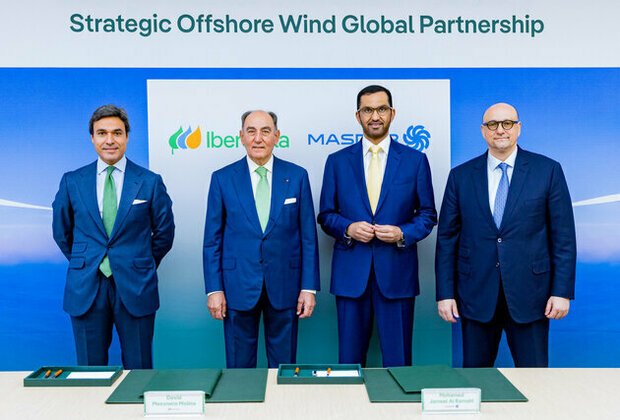The Masdar and Iberdrola clean energy alliance has taken a massive leap forward with a groundbreaking $17.5 billion investment aimed at expanding offshore wind energy projects in the UK and Germany. This historic partnership signals a powerful shift towards a cleaner, more sustainable future for Europe, showcasing the increasing global commitment to fighting climate change and reducing dependence on fossil fuels.
In this detailed article, we explore how these two energy giants are transforming the renewable energy landscape, why the UK and Germany are at the center of this movement, and what this means for global climate goals.
A monumental partnership: Why Masdar and Iberdrola joined forces
Masdar, the Abu Dhabi-based clean energy powerhouse, and Iberdrola, Spain’s leading energy group and one of the world’s biggest renewable energy operators, have been long-time leaders in the green energy transition. Their latest move, joining forces in a $17.5 billion clean energy alliance, is not just a business deal; it’s a significant statement about the future of global energy.

Masdar has already made its mark in over 40 countries, investing in some of the world’s largest solar and wind farms. Iberdrola has been a pioneer in offshore wind, particularly in Europe, with major projects like East Anglia One in the UK and Wikinger in Germany.
The new alliance aims to pool their expertise, technical resources, and financial strength to accelerate offshore wind development, focusing on high-potential markets where demand for renewable electricity is soaring.

Why offshore wind? A powerful source of green energy
Offshore wind has emerged as one of the most promising renewable energy sources. Unlike onshore wind or solar, offshore wind farms benefit from stronger and more consistent winds, leading to higher energy yields.
Key advantages of offshore wind:
- Higher efficiency: Offshore turbines can be larger and more powerful.
- Less visual impact: They are located far from urban areas.
- Greater scalability: Projects can cover vast areas in the sea, generating large amounts of electricity.
By investing heavily in offshore wind, the Masdar and Iberdrola clean energy alliance is betting on a technology that can deliver significant decarbonization results.

The UK: A global offshore wind leader
The UK has positioned itself as a world leader in offshore wind. The country currently has the largest installed offshore wind capacity in the world, with ambitious plans to reach 50 GW by 2030.
Masdar and Iberdrola’s joint investments will support several key projects, including:
- East Anglia Hub, one of the largest offshore wind developments globally, with a planned capacity of over 3 GW
- Hornsea projects, expanding capacity to provide clean power to millions of UK homes
- New innovation centers, focusing on advanced turbine technology and grid integration
This partnership aligns with the UK government’s targets for net-zero emissions by 2050 and strengthens the country’s role as a renewable energy innovation hub.
Germany: Powering Europe’s green transition
Germany is another major focus for the Masdar and Iberdrola clean energy alliance. The country has set ambitious targets to generate 30 GW of offshore wind capacity by 2030 and up to 70 GW by 2045.
Major projects in Germany include:
- Baltic Sea wind farms, expansions to existing farms and development of new areas
- North Sea developments, larger-scale projects aimed at supporting industrial decarbonization
- Hydrogen integration, as offshore wind is expected to power green hydrogen production, a key component of Germany’s energy transition strategy
Germany’s strong regulatory framework, advanced engineering capabilities, and clear climate goals make it an ideal partner for these large-scale renewable initiatives.
Financial commitment: The power of $17.5 billion
The massive $17.5 billion commitment underscores the seriousness of the Masdar and Iberdrola clean energy alliance. This funding will not only build new offshore wind capacity but also support related infrastructure, such as undersea cables, grid upgrades, and energy storage systems.
Key financial highlights:
- Job creation: Tens of thousands of new green jobs across Europe
- Local supply chains: Boost to local manufacturers and service providers
- Technological innovation: Investments in larger turbines, floating wind platforms, and energy digitalization
Global climate impact: A model for other nations
This alliance is more than just a regional project. It sets a powerful example for other countries on how large-scale cooperation can drive rapid energy transformation. By focusing on offshore wind in key European markets, Masdar and Iberdrola aim to prevent millions of tonnes of CO₂ emissions annually.
Their approach offers a template for similar collaborations in Asia, North America, and other regions where offshore wind potential remains untapped.
Beyond energy: Economic and social benefits
Apart from reducing emissions, the Masdar and Iberdrola clean energy alliance promises significant economic and social benefits:
- Energy security: Reducing dependence on imported fossil fuels, especially critical in the current geopolitical context
- Lower energy costs: Renewable energy can stabilize or reduce long-term energy prices
- Community support: Funding for local community initiatives, educational programs, and workforce training
These wide-ranging benefits highlight how clean energy investments can support a fairer, more resilient society.
Overcoming challenges
Large-scale offshore wind projects are not without challenges. They involve complex permitting processes, environmental considerations such as protecting marine life, and grid integration hurdles.
However, the combined expertise of Masdar and Iberdrola, spanning engineering, environmental stewardship, and stakeholder engagement, positions the alliance well to address these challenges head-on.
Moreover, ongoing policy support from the UK and German governments is helping to streamline approvals and provide financial incentives that make these projects more feasible.

Future vision: What’s next for the alliance?
Looking ahead, Masdar and Iberdrola plan to explore further opportunities, including:
- Floating offshore wind, unlocking deep-sea sites previously inaccessible to fixed foundations
- Hybrid energy islands, combining offshore wind with solar and hydrogen production
- International expansion, targeting new markets in Asia-Pacific and the Americas
Their shared long-term vision is to build a global network of renewable assets that can deliver sustainable, affordable energy anywhere in the world.
Conclusion: A transformative moment for clean energy
The Masdar and Iberdrola clean energy alliance marks a defining moment for the global transition to renewable energy. By combining resources and expertise, these two giants are accelerating offshore wind deployment in Europe and setting new standards for international cooperation.
This $17.5 billion investment is more than just a business move. It is a commitment to future generations, to fighting climate change, and to building a more sustainable and equitable world.
As other countries and companies watch this alliance unfold, it is likely to inspire similar bold moves, accelerating the global clean energy revolution.
Follow us on Instagram: UAE STORIES
Read More: Inside Al Habtoor City: Unveiling Iconic Luxury & Legacy














